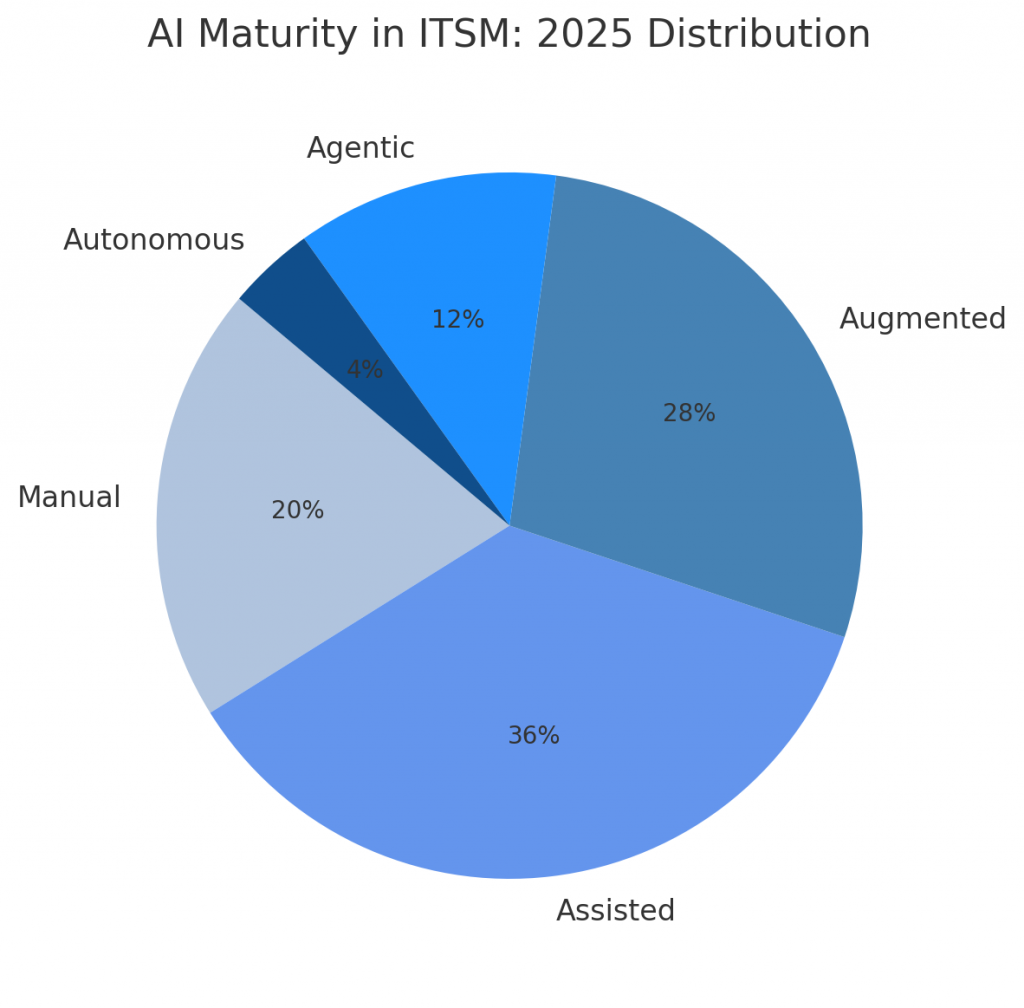The move to Agentic AI isn’t a light switch, it’s a spectrum of capability. While much of the hype suggests organisations are either AI-enabled or not, the reality is more gradual. The Enterprise AI Maturity Index report helps us understand where an organisation currently sits and what steps are needed to move towards more advanced, autonomous operations. For ITSM teams, this shift is already well underway.
Yet, there’s a growing tension. As AI capabilities accelerate, many organisations are struggling to keep up. Some are still grappling with “Digital Transformations” launched years ago that never quite landed. The AI Maturity Index reveals sharp drop-offs as organisations try to move beyond augmentation. Innovation is outpacing the ability to scale safely. Leaders are setting bold AI goals, but measurable results often lag. The result? A widening gap between vision and execution.
Many teams know they must foster a forward looking, AI-driven culture. But without proper governance, frameworks, and support structures, those ambitions can quickly stall. Knowing your maturity stage is one part, having the right guardrails in place to move forward is the other. These guardrails include clear AI governance policies, role based accountability, ethical AI frameworks, data access controls, and transparent auditing mechanisms. Without them, AI deployments can introduce risk, from biased decision making to unauthorised automation that undermines trust and slows adoption.
Why the Maturity Curve Matters to ITSM
Understanding where your organisation sits on the AI maturity curve gives you a practical roadmap. It helps you,
- Set realistic expectations
- Prioritise the right investments
- Avoid over promising outcomes from underdeveloped capabilities
If you’re still relying on rules based chatbots or manually triaging incidents, you’re likely at the Assisted or Augmented stages. But as you integrate systems that proactively fix issues, personalise services, or route tickets based on historical trends without instruction, you’re entering Agentic territory.
Here is a closer look at the stages
- Manual. No meaningful AI in place. Processes are entirely human-driven, often reactive.
- Assisted. Traditional AI helps automate specific tasks (e.g., keyword-based ticket sorting, scripted bots).
- Augmented. AI supports decision making with insights (e.g., recommending actions based on past incidents or usage patterns).
- Agentic. AI operates with autonomy. It learns, adapts, and initiates action without prompts. This includes identifying root causes and executing fixes.
- Autonomous. AI systems collaborate and operate across the environment with minimal oversight, often forming self-improving feedback loops. Think of AI running IT operations end-to-end with human teams focused on exceptions and strategy.
Most ITSM teams don’t leap from stage two to five. They progress gradually. Start with low risk automation tasks. Use machine learning to enrich the CMDB and add predictive insights to incident response. Each step builds confidence and competency.
What IT Leaders are Doing

According to the 2025 AI Maturity Index, 12% of organisations have reached the Agentic stage, Only 4% operate at a truly Autonomous level and the remaining 84% are spread across Manual, Assisted, and Augmented stages, with the majority clustered in the Assisted (36%) and Augmented (28%) tiers. Top-performing organisations,
- Treat AI as a core capability, not an add-on
- Invest in upskilling their IT teams
- Embed governance from the outset
- Prioritise business value over technical novelty
If you’re still unsure where you stand, try mapping recent service improvements or AI projects to the maturity model. Are your tools initiating outcomes, or just helping humans decide?
What’s Holding Organisations Back?
Legacy Infrastructure
Many organisations are still running on fragmented systems that weren’t designed for modern AI integration. Without unified data models and APIs, it’s difficult for AI agents to operate across workflows autonomously.
Data Quality and Accessibility
Agentic AI depends on high quality, well-governed data. Inconsistent, siloed, or incomplete data makes it impossible for AI agents to learn, adapt, and act reliably without human correction.
Lack of Governance and Oversight Models
As AI becomes more autonomous, governance becomes more complex. Many organisations lack clear frameworks for auditing decisions, assigning accountability, and managing risk, all of which are essential at the Agentic stage.
Workforce Readiness and Resistance
IT teams may lack the necessary skills to deploy and monitor Agentic systems. There’s also resistance from staff worried about job displacement, which can stall adoption unless the narrative shifts to augmentation, not replacement.
Unclear ROI or Value Metrics
Unlike traditional automation, the value of Agentic AI isn’t always immediate. Organisations often struggle to define and measure success, which makes it harder to justify further investment beyond pilots or proof-of-concepts.
Agentic AI isn’t just a new tool. It marks a shift in how ITSM is delivered. By understanding the maturity model and recognising your current state, you can plan upgrades, staffing, and strategies more effectively. The goal isn’t to jump to full autonomy overnight. It’s to move with clarity and purpose, one level at a time.
FAQ Questions
How does the AI maturity curve apply to ITSM?
The AI maturity curve outlines how ITSM teams progress from manual tasks to autonomous systems. It helps identify where you are today and what you need to do to move forward strategically.
What is Agentic AI in service management?
Agentic AI refers to systems that can independently take action, learn from experience, and adapt to new situations without being told what to do. In ITSM, it means AI fixing problems before humans notice them.
Why are most organisations stuck at the Assisted or Augmented stages?
Many still rely on legacy systems, poor data quality, and unclear governance. Even teams with good intentions struggle to move forward without clear value metrics and staff readiness.
What’s the first step to reaching the Agentic stage?
Start small with low risk automation that improves data quality or incident response. Build the right governance frameworks early and involve your team to avoid resistance and confusion.
🔗 Further Information
